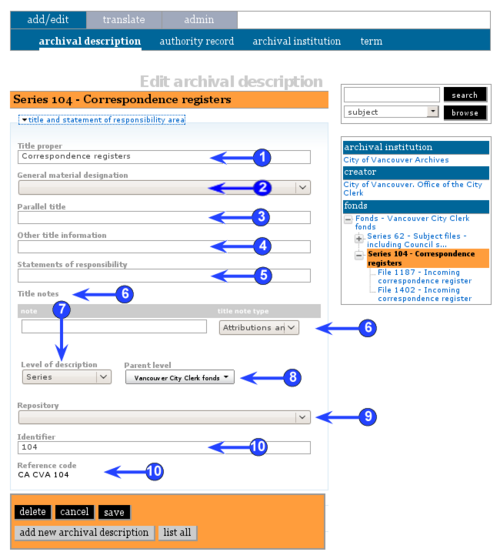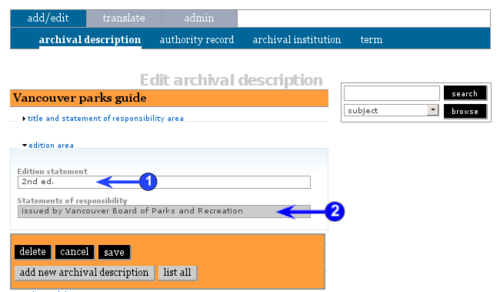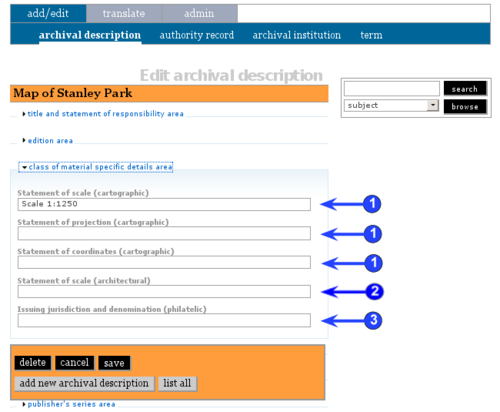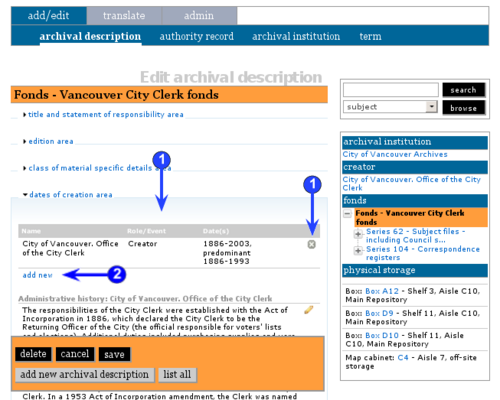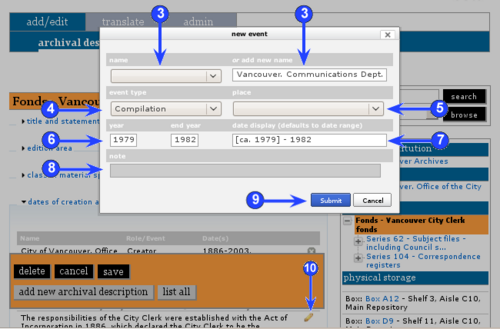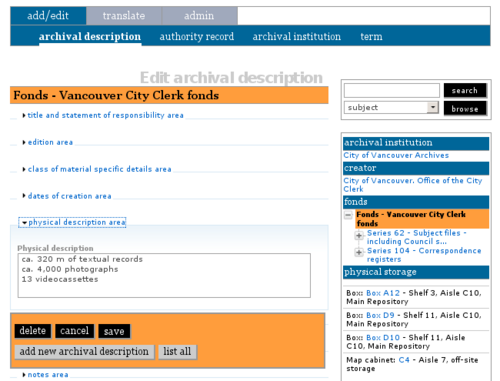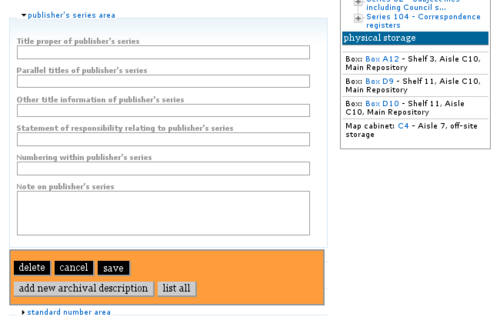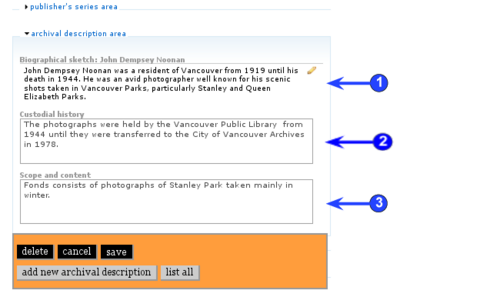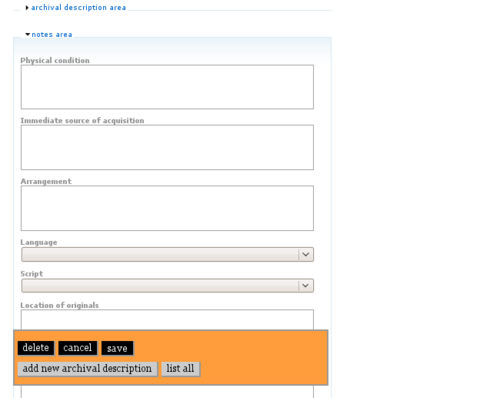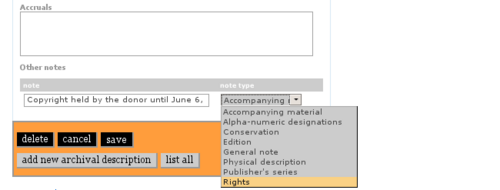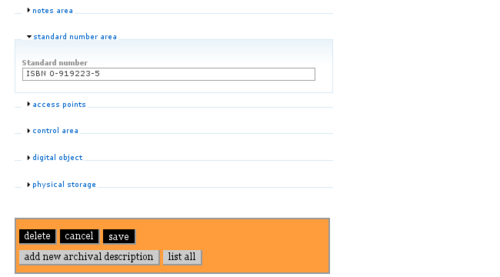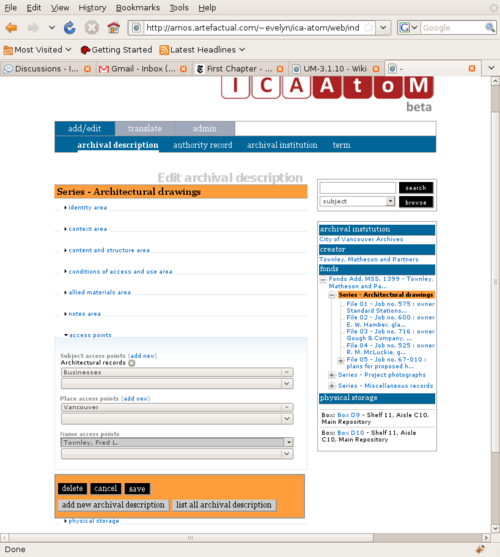Rules for Archival Description
Please note that ICA-AtoM is no longer actively supported by Artefactual Systems.
Visit https://www.accesstomemory.org for information about AtoM, the currently supported version.
RAD elements
Main Page > (UM) User manual > UM-3 Add / edit content > UM3.1 Add / edit archival descriptions > UM-3.1.7 RAD elements
Title and statement of responsibility area
The title and statement of responsibility area contains fields that map to RAD area 1.1 and the .1 rules in the media chapters. It is used for recording the title and identifiers of the unit of description.
1. Title proper
- "The chief name of a unit being described, including formal or supplied titles, but excluding parallel titles and other title information" (RAD Glossary).
- For rules and examples, see RAD 1.1B and the .1B rules in the media chapters.
2. General material designation
- "A term indicating the broad class of material to which the unit being described belongs" (RAD Glossary).
- ICA-AtoM ships with a default value list of GMD terms based on RAD's prescribed terminology; the list can be customized by editors and administrators (material type taxonomy).
- Select as many GMD terms as are appropriate.
- For rules and examples, see RAD 1.1C and the .1C rules in the media chapters.
3. Parallel title
- "The formal title proper in another language and/or script" (RAD Glossary), typically appearing in conjunction with the formal title on the chief source of information.
- For rules and examples, see RAD 1.1D and the .1D rules in the media chapters.
4. Other title information
- "Title information usually appearing in or on the chief source of information in conjunction with a title proper, other than the title proper or parallel title" (RAD Glossary).
- For rules and examples, see RAD 1.1E and the .1E rules in the media chapters.
5. Statements of responsibility
- "A statement that appears in conjunction with a formal title, relating to the personal author(s) of the document, to corporate body (bodies) or a family (families) from which the content emanates, or to person(s) or corporate body (bodies) responsible for the performance of the content of the document" (RAD Glossary).
- Only applies at the item level.
- For rules and examples, see RAD 1.1F and the .1F rules in the media chapters.
6. Title notes
- This is a multi-value field for registering and displaying the notes relating to the title of the unit of description. RAD includes 6 types of notes relating to title (see RAD 1.8B1 through 1.8B6).
- Enter the note.
- Select the type of note.
- When you click the save button in the button block the note will be registered and will now appear in the list above the data entry fields.
- There is no limit to the number of title notes you can add, but as of the current version of ICA-AtoM (v1.0 beta) you can only register them one at a time: i.e. enter the note, select the type, click the save button and repeat for each additional note.
- To delete a title note, click the delete icon.
- Title notes do not appear with other notes in the RAD notes area.
7. Level of description
- Select the level of description.
- ICA-AtoM ships with a default value list of levels of description; this can customized by editors and administrators (levels of description taxonomy).
8. Parent level
- Select the unit immediately above the current one in the hierarchy of arrangement (the parent record).
- Leave blank if the current unit represents the highest level of arrangement (e.g. a fonds).
9. Repository
- From the drop-down menu, select the archival institution that holds the archival material being described.
- The list in the drop-down menu is generated from all existing archival institution records.
- If the repository does not appear in this list, you need to create it separately; see UM-3.3 Add / edit archival institutions.
- Typically you need only enter this information at the highest level of description; it can be left blank at the lower levels if they are all held by the same repository.
10. Identifier and Reference code
- Enter the code / number that uniquely identifies the unit of description within the archival institution.
- ICA-AtoM generates a globally unique identifier (reference code) by combining:
- the unit's identifier;
- the institution's repository code;
- the institution's country code (based on ISO 3166).
- A country code and repository code will automatically be included in the reference code whenever the highest-level archival description is linked to an archival institution (see UM-3.1.5 Context area). The archival institution description must have the following fields filled out in order for this to happen: the identifier field in the identity area (see UM-3.3.4 Identity area) and the country field in the contact area (see UM-3.3.5 Contact area).
- Information entered into the identifier field at lower levels of description will appear as part of the reference code when the archival description is saved and displayed.
- Each child archival description will inherit reference code data entered at the parent levels of description.
- Note that the reference code will not be displayed in either the edit screen or view screen for any description that does not have its own identifier.
Edition area
The edition area contains fields that map to RAD area 1.2 and the .2 sections of the media chapters. It is used "only in item level description to record statements relating to versions of items existing in two or more versions or states in single or multiple copies." (RAD 1.2A1).
1. Edition statement
- Enter edition statements relating to the item being described.
- For rules and examples, see RAD 1.2B.
2. Statements of responsibility
- Transcribe statements of responsibility relating to one or more editions.
- For rules and examples, see RAD 1.2C.
Class of materials specific details area
The class of material specific details area contains fields that are applicable only to certain media types. It corresponds to the .3 sections in RAD's media chapters.
1. Cartographic records
- Enter statements of scale, projection and coordinates.
- For rules and examples, see RAD 5.3 Mathematical data area.
2. Architectural and technical drawings
- Enter statements of scale.
- For rules and examples, see RAD 6.3 Scale area.
3. Philatelic records
- Enter information relating to the jurisdication that issued the stamps and the denominations they represent.
- ICA-AtoM combines what are two separate element in RAD into a single field because the relation is often 1 to many, i.e. one jurisdiction, many denominations (e.g. Canada: 5 cents, 40 cents).
- For rules and examples, see RAD 12.3 Issue date area.
Dates of creation area
The dates of creation area contains fields that map to RAD area 1.4. In ICA-AtoM it is used for registering both the dates of creation of the descriptive unit, as well as the name of the creator(s). Because of the way ICA-AtoM implements dates, this information area contains some element not found in RAD.
ICA-AtoM manages date ranges as events that links an actor (corporate body, person or family), described in an authority record, to an archival unit in a type of role (e.g. creator, accumulator, custodian) over a certain period of time.
- At the highest level of description, the archival unit should always be associated with its creator over the date range of the material.
- At lower levels of description, enter the date range only to inherit the creator from the higher level (i.e. a description will inherit the creator if creator name is left blank).
- At any level you can associate a description with multiple creators over different date ranges.
- At any level you can assign multiple types of relations; this will be primarily useful at the item level (e.g. date of creation vs broadcasting).
1. Name, Role/event, Dates
- When you first open the dates of creation area information area, the list displays the existing event entries.
- To delete an event, click the delete icon next to it in the list.
2. To register a new event, click the add new link. ICA-AtoM opens a pop-up dialog box for data entry.
3. Name / Add new name
- Select the creator's name from the drop-down menu (generated from the names of all existing authority records).
- If the creator's name does not appear in the menu, use the add new name field to enter the name.
- If you select a name from the drop-down list, ICA-AtoM will ignore any text you may have entered in the add new creator name field.
- Note that you can leave both of these fields blank; in this case, the unit will inherit creator information from its parent record.
- At the highest level of description, you should always include the creator; the administrative / biographical history is drawn from the creator's authority record.
- Lower levels inherit creator information from higher levels: use only if the creator is different at the lower and higher levels.
4. Event type
- Select the type of event from the drop-down menu.
- The value list is drawn from the Event types taxonomy and can be edited by system administrators and editors (some terms in this taxonomy, however, are locked because they are accessed by the software code).
5. Place
- Select the place of creation if relevant.
- As of the current version of ICA-AtoM (1.04 beta) you cannot directly add a new place term from this pop-up box.
- To add new place terms, you must edit the Places taxonomy; for editing taxonomies, see UM-3.5.1, Add a new to a taxonomy.
6. Year / End year
- Enter the start and end year of the date range.
- ICA-AtoM uses these values for sorting and searching purposes.
- Use only four-digit numbers.
- If the start and end years are the same, enter only in the year field and leave the end year blank.
- Complete at lower levels of description even if you are leaving the creator name field blank (e.g. when describing a series, you do not need to repeat the creator name from the fonds description, but you do need to entr the date range of the series).
- Do not use any qualifiers here (e.g. "ca.") or typographical symbols (e.g. "[194?]") to express uncertainty (see step 4).
7. Date display
- Enter the date range as you want it to appear in view mode.
- Add any additional text to qualify date range (e.g. "ca. 1940-1980" or "[1940]-1980, predominant 1973-1980").
- Whereas creation year and end year are used internally for database searching and sorting purposes, this field is for display purposes.
8. Note
- Enter any additional information relating to the event.
9. Click the Submit button. The event will now appear in the list. Note that the event is not registered to the system until you click the Save button; once saved, the name will appear as a link.
10. Administrative history / biographical sketch
- If you have registered more than one creator in the events area, the administrative histories / biographical sketches of each will appear here sequentially, separated by a line.
- This data actually reside in the creator's authority record. It cannot be directly edited here; to edit, click the edit icon; ICA-AtoM routes you to the related authority record in edit mode. Make changes to the history field and save; ICA-AtoM returns you to the edit screen and re-loads the page, collapsing all information areas.
Physical description area
The physical description area contains fields mapping to RAD area 1.5 and the .5 sections of the media chapters. It is used to record "the extent of the unit being described (including specific material designation), other physical details or the dimensions when appropriate." (RAD 1.5A1).
RAD contains four distinct elements in this area: Extent of descriptive unit (including specific material designation) (1.5B); Other physical details (1.5C); Dimensions (1.5D); and Accompanying material (1.5E). ICA-AtoM collapses these into a single Physical description field in order to accommodate multiple extent statements, each of which may contain different information relating to other physical details, dimensions, etc.
For rules and examples, see RAD 1.5 and the .5 sections in any of the relevant media chapters.
Publisher's series area
The publisher's series area contains fields mapping to RAD area 1.6 and the .6 sections of the media chapters. It is used "only for describing an item bearing a publisher's or artist's
series title" (RAD 1.6A1). It contains the following text fields; for rules and examples, refer to the applicable RAD sections:
- Title proper of publisher's series (RAD 1.6B)
- Parallel titles of publisher's series (RAD 1.6C)
- Other title information of publisher's series (RAD 1.6D)
- Statement of responsibility relating to publisher's series (RAD 1.6E)
- Numbering within publisher's series (RAD 1.6F)
- Note on publisher's series (RAD 1.8B10).
Archival description area
The archival description area maps to RAD area 1.7 and the .7 sections in the media chapters. It is used "to present information about the context and content of the unit being described" (RAD 1.7A1).
1. Administrative history / Biographical sketch
- Displays data from the related authority records of any corporate bodies, persons, families registered in creation events in the Dates of creation area.
- To edit, click the edit icon (pencil); this takes you to the related authority record for editing.
- To add an administrative history / biographical sketch, register the creator in the Dates of creation area.
- The field label changes depending on the type of entity: Administrative history (corporate bodies), Biographical sketch (persons and families), History (entity type not entered).
2. Custodial history
- "Give the history of the custody of the unit being described, i.e., the successive transfers of ownership and custody or control of the material, along with the dates thereof, insofar as it can be ascertained" (RAD 1.7C).
- For rules and examples, see RAD 1.7C and the .7C sections of the relevant media chapters.
3. Scope and content
- "Give information on the type of function or activity to which the records comprising the unit being described pertain, the relationship between them, the organization of the records, and their documentary forms" (RAD 1.7D).
- For rules and examples, see RAD 1.7D and the .7D sections of the relevant media chapters.
Notes area
The notes area contains fields that map to RAD area 1.8 and the .8 rules of the media chapters. It is used "for descriptive information that cannot be fitted into other areas of the description" (RAD 1.8A1). RAD includes 30 elements as distinct types of notes in this area. A number of these have analogues in ISAD(G) where they are treated as descriptive elements in their own right rather than "notes".
ICA-AtoM implements this RAD area as follows:
- Those notes (13 in total) that have ISAD(G) analogues are mapped to their own fields in this information area.
- The remainder are managed by a generic Other notes field with a Note type drop-down menu.
For content rules and examples, see RAD 1.8 and the .8 rules in the relevant media chapters.
There are several RAD notes that do not appear in this information area. These appear elsewhere in the RAD data entry template:
- Notes relating to title (1.8B1 through 1.8B6) are included in the Title and statement of responsibility area.
- Notes relating to dates of creation (1.8B8) and accummulation (1.8B8a) are included in the Dates of creation area.
- Notes relating to publisher's series (1.8B10) are included in the Publisher's series area.
Standard number area
The standard number area maps to RAD area 1.9 and the .9 rules in the media chapters. It is used "only in item level description to record international standard numbers pertaining to the item" (RAD 1.9A1).
1. Standard number
- "Give the International Standard Book Number (ISBN), International Standard Serial Number (ISSN), or any other internationally agreed standard number for the item being described" (RAD 1.9B1).
- For content rules and examples, see RAD 1.9 and the .9 rules in the relevant media chapters.
Access points
The access points area links archival descriptions to terms drawn from controlled vocabularies as a means of facilitating access and retrieval. The current version of ICA-AtoM (v1.0 beta) supports subject, place, and name access points.
- ICA-AtoM implements access points as multi-value fields.
- Select a term from one of the drop-down menus; when you save the record, the access point will be registered and will now appear in the list above the data entry fields.
- There is no limit to the number of access points you can add. When one term is entered, ICA-AtoM automatically provides fields for entering more terms.
- To delete an access point, click the delete icon next to it in the list.
1. Subject and Place access points
- The values in the drop-down menus are drawn from the subjects and places taxonomies.
- Both taxonomies can be edited by administrators and editors on the list taxonomy terms screen.
- If the subject or place you want to use does not appear on the menu, you (or your system administrator or editor) must first add it to the taxonomy.
- For more on editing terms and adding to taxonomies, see UM-3.5 Edit taxonomies.
2. Name access points
- The values in the drop-down menu are all drawn from existing authority records.
- If the name you want to use does not appear in the list, you must first create its authority record.
- For more on creating authority records, see UM-3.2.1 Add / edit authority records > Create a new authority record.
